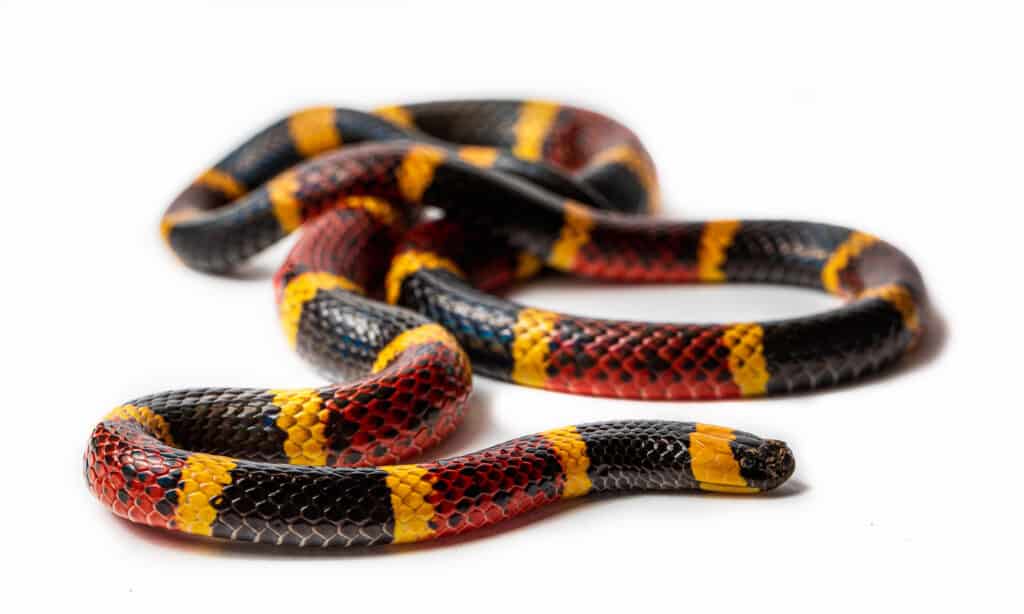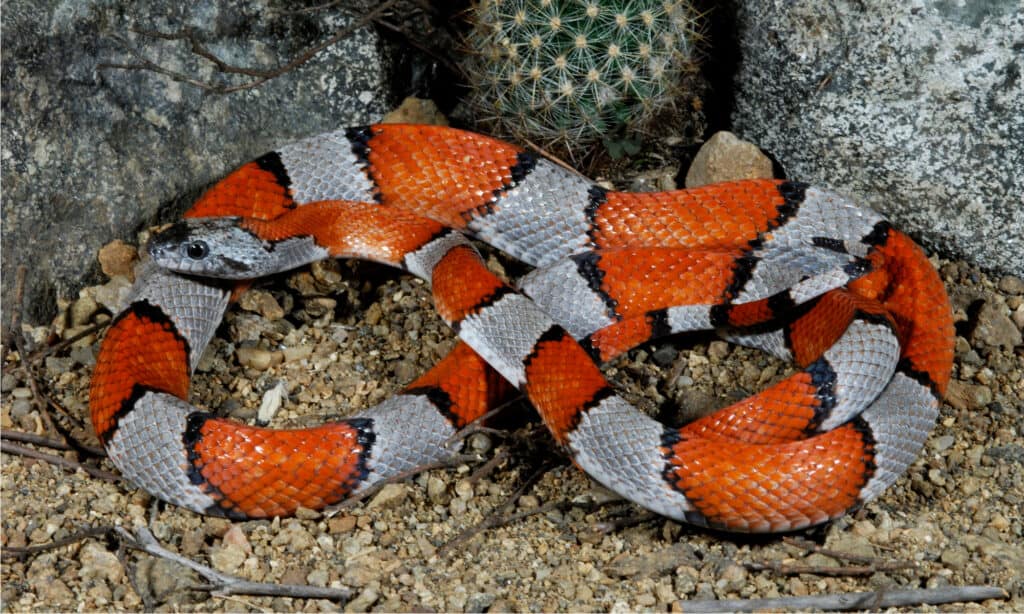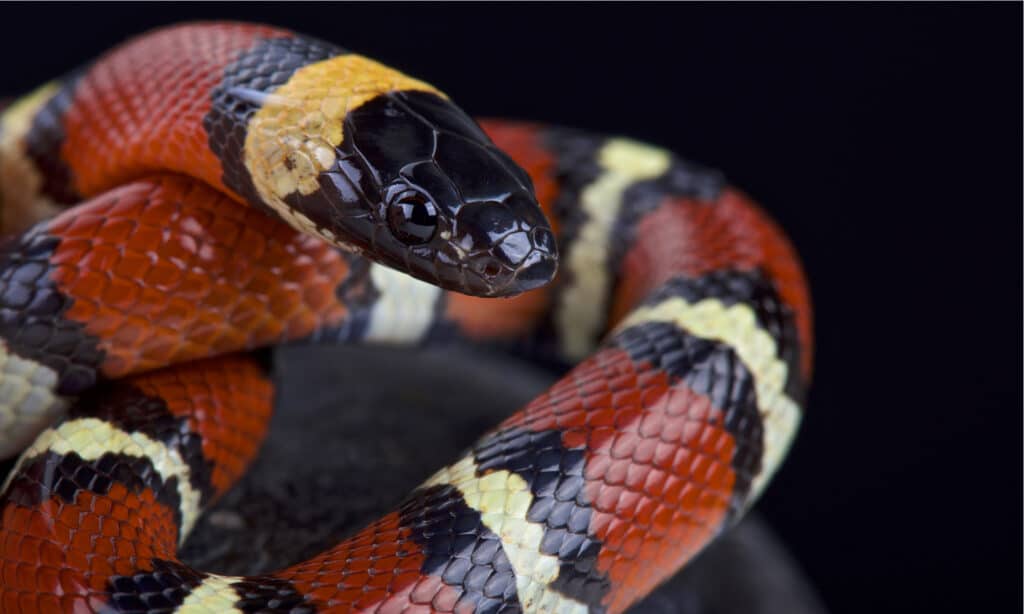Texas is one of the largest states in the U.S., and consequently, it is home to over a hundred different species of snake. Thankfully, most of the snakes in Texas are harmless, but there are still dangerous ones out there. Of the about 105 species found in the state, only 15 are potentially dangerous to humans.
However, one of those venomous snakes rarely ever comes out, and few people ever see them slithering around. The coral snake is one of the most vibrant and beautiful snakes in Texas, but it is also one of the most venomous!
Let’s learn all about coral snakes in Texas, plus a bit about their lookalikes!
What is a coral snake?

There are three species of coral snake in North America, and one of them lives in Texas.
©iStock.com/JasonOndreicka
Coral snakes are a group of snakes that live in both the New World and the Old World. All of the coral snake species that can be found in the Americas belong to the Micrurinae subfamily, of which there are 65 recognized species. These snakes are all venomous and are closely related to cobras! Although 62 of the 65 coral snake species are found in Central and South America, there are still three inhabitants here in the United States!
Across the United States, there are three species of the coral snake, but most people will never see one in the wild. These snakes are secretive, nocturnal, and spend most of their day underground or in dense undergrowth. Run-ins with these snakes are rare, and bites are even rarer. Although they are among the most venomous snakes in the United States, they would much prefer to go on their way and aren’t prone to bite people.
Let’s take a look at one species of coral snake in Texas, plus a few of the associated subspecies.
Coral Snakes in Texas
Texas coral snake (Micrurus tener)

The
Texas coral snake
used to be considered a subspecies of the eastern coral but is now recognized as its own species.
©Scott Delony/Shutterstock.com
The Texas coral snake is one of three species of coral snake in North America. Until recently, Texas coral snakes were classified as subspecies of the eastern coral snake. After some research, however, it was determined that there were enough morphological differences between the two to separate them into their own species.
Identification: The Texas coral snake has a similar coloration and pattern to the other coral snakes that can be found in North America. Like the others, the banding repeats a pattern of black, yellow, and red bands.
In the Texas coral snake specifically, the black and red bands are large, while the yellow bands are generally thinner. Additionally, coral snakes have inky blackheads with black eyes. Their coloring wraps all the way around their bodies and doesn’t end near the sides as some mimic snakes do.
The main differences between a Texas coral snake and an eastern coral snake are size and venom. Texas coral snakes are described as being “longer and stouter” and having a larger venom yield than the eastern coral.
Distribution: The Texas coral snake can be found in the following regions: South Texas Plains, Gulf Coast, Pineywoods, Prairies and Lakes, and Hill Country. They cannot be found in Big Bend Country or in the Panhandle Plains.
The five subspecies of the Texas coral snake
There are five recognized subspecies of the Texas coral snake. Of these subspecies, only M. tener tener is found in Texas, with the others found in Mexico.
The five subspecies of the Texas coral snake are:
- Micrurus tener fitzingeri – Guanajuato coral snake
- Micrurus tener maculatus – Tampico coral snake
- Micrurus tener microgalbineus – Spotted coral snake
- Micrurus tener tamaulipensis – Tamaulipas coral snake
- Micrurus tener tener – Texas coral snake
Commonly misidentified as coral snakes
There are many species of snake that look incredibly similar to the coral snake. In fact, many of them are evolved to be identical! Let’s take a look at these potential lookalikes and learn how to differentiate them. All of these snakes are nonvenomous and harmless to humans.
Western milksnake

Western milksnakes are vibrant snakes that mimic the coral snake for protection.
©Matt Jeppson/Shutterstock.com
The western milksnake is a coral snake mimic belonging to the Lampropeltis genus, marking it as a kingsnake. Western milksnakes can be identified by their banding, which goes red, black, and white. Coral snakes don’t have red bands touching black, making this the key to telling these two apart. Additionally, western milksnakes don’t have complete banding down their bodies, as their white bands dissolve into their white bellies.
Western milksnakes can be found across the eastern and western regions of the state and into the panhandle. They aren’t present in central or south Texas.
Gray-banded kingsnake

The gray-banded kingsnake has gray bands instead of yellow or white like the coral snake.
©Breck P. Kent/Shutterstock.com
Gray-banded kingsnakes are members of the Lampropeltis genus as well, although the kingsnake designator is already present in their name. They are coral snake mimics with a banding pattern that goes red, black, and gray. The black bands are very thin compared to a coral snake, plus coral snakes don’t have gray on their bodies.
Gray-banded kingsnakes can be found in the desert and mountains near the border of West Texas and Mexico. They are found between 1500 and 7000 feet above sea level.
Mexican milksnake

Mexican milksnakes have blackheads, making their banding pattern the best way to differentiate them from coral snakes.
©reptiles4all/Shutterstock.com
Mexican milksnakes (also known as Tamaulipan milksnakes) are coral snake mimics that belong to the Lampropeltis genus, designating them as kingsnakes. They are very similar in appearance to coral snakes and even have the characteristic blackheads that corals do.
The best way to tell the difference is through the banding pattern. Mexican milksnakes have a banding pattern that goes thick red, thin black, and thin yellow. Coral snakes in the United States don’t have black and red banding next to one another.
Mexican milk snakes are found in the far southern regions of Texas.
Texas long-nosed snake

The long-nosed snake has a washed-out appearance and incomplete banding down its body.
©jokerbethyname/Shutterstock.com
Texas long-nosed snakes are coral snake mimics that are generally easy to differentiate from coral snakes. These snakes have incomplete black and red banding. Additionally, they have white scales across their backs, giving them a washed-out look. Another differentiator is their slightly upturned snout.
The long-nosed snake can be found in almost all of Texas except the eastern third of the state.
What is a coral snake mimic?
Coral snakes are some of the most venomous snakes here in North America. As a result, many animals know to stay away from them if they want to live long lives! Over evolutionary history, these animals have evolved to avoid brightly colored snakes with red, black, and yellow on them.
Other snakes that slightly resembled the coral snake ended up getting the same special treatment from potential predators that the coral snake was receiving! Over time, these snakes became better and better at mimicking coral snakes to keep predators at bay since they were nonvenomous themselves.
This form of evolutionary defense through copying is known as Batesian mimicry and can be found worldwide in many different species.
Other Reptiles Found in Texas

The Texas horned lizard is a native species of lizard that calls Texas home.
©Seth LaGrange/Shutterstock.com
Texas is home to a diverse array of wildlife, including a number of reptile species. While many may immediately think of snakes when considering.
Texas reptiles, there are actually a wide variety of other reptiles found throughout the state. From the armored and spiny Texas horned lizard to the slow-moving and long-lived desert tortoise, there are plenty of unique and fascinating reptiles to discover in Texas.
Here is a short list of other reptiles found in Texas:
- Texas horned lizard (Phrynosoma cornutum)
- American alligator (Alligator mississippiensis)
- Green anole (Anolis carolinensis)
- Texas spiny lizard (Sceloporus olivaceus)
- Desert tortoise (Gopherus agassizii)
- Red-eared slider turtle (Trachemys scripta elegans)
The photo featured at the top of this post is © iStock.com/JasonOndreicka
Discover the "Monster" Snake 5X Bigger than an Anaconda
Every day A-Z Animals sends out some of the most incredible facts in the world from our free newsletter. Want to discover the 10 most beautiful snakes in the world, a "snake island" where you're never more than 3 feet from danger, or a "monster" snake 5X larger than an anaconda? Then sign up right now and you'll start receiving our daily newsletter absolutely free.
Thank you for reading! Have some feedback for us? Contact the AZ Animals editorial team.






